Modern Sensibilities
Welcome to the first week of Modern Horizons previews. I'm going to talk about the new set, how it came into being, and how it was designed. I'll then show you a cool preview card. If that sounds like fun, proceed to the next paragraph.
Hacking It
A number of years ago, we needed to come up with an idea for the 2019 innovation product. Past years had been things like the Un- sets, Conspiracy, Battlebond, Planechase, and Archenemy. (Both the Commander decks and the Masters sets started as innovation products.) To come up with an idea, Mark Globus suggested something a little unorthodox: What if R&D took a week off to work on a series of pitches? Each person would be assigned to one team and then at the end of the week, that team would produce a playable prototype. He called it a Hackathon. (Hackathons are sprint-like events usually seen in the computer software industry.)
Mark Globus (co-lead vision designer and co-lead set designer)

Mark Globus owes his job at Wizards to airline ticket pricing. You see, he was in the top five of the first Great Designer Search but got cut before the Top Three (who we flew out to Wizards for a day of interviews). Because ticket prices skyrocket as you get closer to the travel day, it was cheaper for us to buy tickets for the Top Five than wait and find out who the Top Three were. We ended up flying Mark Globus out for some interviews, because we'd already bought the ticket and he looked like a good candidate. Obviously, the job interviews went well.
Globus ended up getting a job in our Digital Games department, but it wasn't long before he made the transition over to Magic R&D. He has served as a producer and a product architect, both positions that oversee a product from start to finish. Working with Globus is always a pleasure because he has a great eye for the product as a whole and how it will interact with all the other departments at Wizards. Globus would end up being the co-lead designer for both vision design and set design of Modern Horizons, seeing the product all the way through its creation.
The Hackathon was going to have slots for six product teams. Anyone could pitch an idea, and Globus would take the six he felt showed the most promise. My idea was pretty simple. I walked in his office and said, "Future Sight 2." (You have to imagine this with me making exciting hand gestures.) The original Future Sight had been an overly complex design that went over the heads of most of our less enfranchised players, but was beloved by the dedicated Magic community. The set was overrunning with mechanics (the set had almost 50, nearly as many present within the entire game at the time), but it was exciting and fun, provided you understood what was going on. My pitch was that there was a dedicated audience that appreciated that kind of set. It wasn't something we could make Standard-legal, but perhaps as a supplemental product.
Ethan Fleischer, meanwhile, gave Globus a similar pitch—"Time Spiral 2." (I wasn't there, but knowing Ethan, I don't think his hand gestures were nearly as impressive.) Ethan and I each had a slightly different vision for the product, but we shared one common goal—making a more complex, nostalgia-rich supplemental product aimed at an enfranchised crowd who would appreciate a higher complexity level.
Ethan Fleischer (co-lead vision designer)
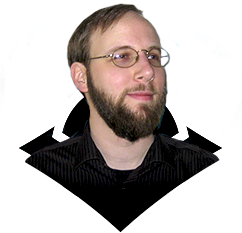
Ethan is probably best known as the winner of the second Great Designer Search. He's been on numerous design teams and has led (or co-led) the design/vision design for Journey into Nyx, Commander (2014 Edition), Oath of the Gatewatch, Commander (2016 Edition), Amonkhet, and Core Set 2019. He also lead the vision design for "Baseball" and "Equestrian," two future sets that you all know nothing about. Ethan is an amazing designer and has only gotten better over the years since joining R&D. He was the lead of the Hackathon team and the co-lead of the Vision Design team for Modern Horizons.
Globus called me and Ethan into his office and informed us that he was going to combine our two ideas into a single product team for the Hackathon. We'd both be on the team, with Ethan serving as the lead. Ethan and I chatted about the product and realized we were basically on the same page. We even agreed on the codename for the product in the Hackathon. We called it "Decadence." Besides Ethan and myself, the team would have one full-time member (Alli Medwin) and one part-time member (Nat Moes).
Alli Medwin
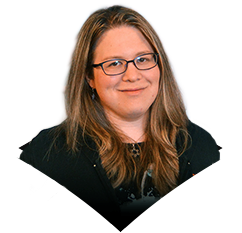
Alli has worked mostly on Magic digital products, but she enjoys designing cards and will do so whenever she's given an opportunity. Alli has a wonderful energy and was one of the biggest cheerleaders for "Decadence," volunteering for our team the second she heard what we were up to. Alli has played the game for a long time and loves diving deep into Magic nostalgia. I can be a bit of a firehose when I get going, but Alli had no problem keeping up and often surpassing my output. Alli would not only be on the Hackathon team but was also a member of the Modern Horizons Vision Design team.
Nat Moes
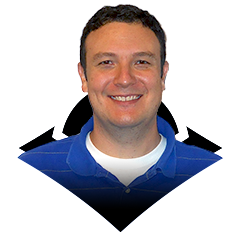
Nat is a big fan of Vintage. He's also been playing Magic for many years and has a good memory for Magic's past. He was on our Delta team as one of the editors for Magic. The editors had too much work to take the Hackathon week off, but Nat joined our meetings whenever he had free time. His designs were always fun and excellently templated.
Here's how the Hackathon worked. We had one week to make a playable prototype. For some teams, the time was spent figuring out how to make their particular idea work, resulting in two playable decks at the end of the week. Not us. Our set wanted to capture the fun of Time Spiral block, which meant it was all about the card designs. What kind of playtest would sell our product? Not preconstructed decks. We wanted Globus and the other judges to have to sort through all the cards and soak in the true decadence of "Decadence." We decided the only way to do this would be a Sealed playtest. That meant we had a week to design a large set's worth of cards, and not just simple cards—a Time Spiral block level of complexity. Challenge accepted!
We would work at our desks for a few hours designing as many cards as we could and then get together to share what we've done. The reason we got together was as much to inspire one another as it was to piece together the set. As the team lead, Ethan was doing most of the set construction, leaving Alli, Nat, and me to design as many cards as we could.
The goal of our designs was fourfold:
- We were free to make use of any and every mechanic.
- There were no complexity guidelines. We were not following New World Order.
- We were trying to tap into nostalgia, so whenever possible, we were looking for ways to tie our designs into Magic's history.
- We wanted the set to be fun and bring a smile to anyone looking at the cards.
Of the team, I was the only one who had worked on Time Spiral block (I'd been on Time Spiral and Planar Chaos designs, and lead Future Sight), so only I knew the pure joy of design we were getting ourselves into. We had a blast that week. Ethan worked around the clock getting the card file into shape while the rest of the team kept pumping out more and more cards. In one week, we designed more than we needed.
On Friday, Mark Globus and the fellow judges walked into our playtest. I believe Ethan had withheld telling him that we were doing a Sealed playtest, so when Globus sat down and asked, "So what are we doing?" Ethan handed him a stack of cards and said, "Build a deck." Deck building took a while because the judges were reading all the cards and laughing. Finally, they put their decks together and played. And it played well. We had not only made a large set in a week but had managed to make something that showed off the potential of the gameplay. I believe it was just a week later that we were told that "Decadence" had been selected for the 2019 innovation product slot. (There were a bunch of other cool products, some of which you'll see in the future.) That meant we had no time to waste. We needed to put together a Vision Design team because we had a set to make.
Creating a Vision Design Team
When Mark Globus decided to make "Decadence" the 2019 innovation product, he had one big suggestion. What if we made the product playable in Modern? Normally, for Modern to get new cards, they first have to appear in a Standard-legal set. This puts a lot of restrictions on what cards we can make. For years, we'd talked about the idea of a straight-to-Modern set but never found the right idea for the product. Mark's suggestion was that "Decadence" could be that product.
The idea came with a lot of baggage. First, it would require a bunch of playtest resources as we wouldn't want to add cards straight to Modern without having some idea what impact they might have. Second, it affected what reprints we would want to use. In the Hackathon, we limited ourselves to reprints that felt Time Spiral-y. With the straight-to-Modern twist, it meant the reprints would be cards that weren't in Modern but would get added to Modern because of their inclusion in this set (with one exception—a cycle of cards I'll talk about next week). Third, it would impact what mechanics we'd have access to. The constraint Globus put into place was that we'd only use mechanics already in Modern and wouldn't use mechanics later than Dragons of Tarkir. (If the product was successful, this would leave us room to do another one later.) If that sounds a bit restrictive—it really wasn't. We've made a lot of mechanics between Eighth Edition (2003) and Dragons of Tarkir (2015), and the best of the early mechanics had been repeated during this time frame. And yes, if it appeared on the Time Spiral bonus sheet or in Future Sight, even on only one card, it counted. (That got us a bunch of the older mechanics.)
Globus understood that this was going to be a tricky product to move through the system (it was unlike any product we'd ever made before and made a lot of people elsewhere in the company nervous), so he decided that he would co-lead both the vision design and the set design. Adam Prosak would be the co-lead set designer. As for the Vision Design team, he asked Ethan to co-lead with him as Ethan had led the set for the Hackathon. Alli was also asked to be on the team because of all her hard work during the Hackathon and her overall enthusiasm for the product. Globus knew we needed a play designer who could focus on the Modern playtesting for the set. He also budgeted for some contractors to specifically playtest Modern. The person Globus selected was Mike Majors.
Mike Majors
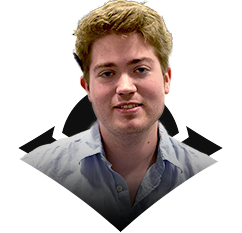
Mike is a former pro player (he has four Grand Prix Top 8s, including a win at GP San Diego 2015, and three Pro Tour Top 16s) known for his deck-building skills. He was recruited by the Play Design team shortly after it was formed. Mike was added to the Modern Horizons Vision Design team to be the authority on what Modern needed. He and the contractors were responsible for playtesting and providing the team with notes about what cards would help support Modern, including ones that would prop up decks a little below the top tier. This was my first time working with Mike on a team, and he was amazing. The team had very little tactical information on Modern, and Mike's expertise on the format was crucial to the product's success.
Globus came to me to ask about the final slot of the Vision Design team. The Standard-legal sets keep me pretty busy, but I try to be on the occasional supplemental team when I can. Remembering all the fun I had of working on Time Spiral block as well as the Hackathon, I joined up without a hesitation.
Mark Rosewater
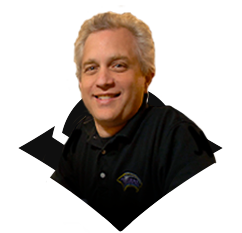
This October will mark my 24th year working on Magic, and Modern Horizons was something like my 70th design team. (You tend to lose count somewhere in the 30s.) Modern Horizons was a blast to design. Metaphorically, it's as if I'm used to driving 55 miles per hour on the freeway and then, one day, I get to the Autobahn and I'm told I can go as fast as I want. The freedom of Modern Horizons design was exhilarating. It's also cool to say "I'm going to use this mechanic and this mechanic and this mechanic." If it's not clear, I had a lot of fun working on Modern Horizons.
The Vision Design team was set. It was Globus and Ethan co-leading Alli, Mike, and me. Before we could begin designing cards, though, we had to figure a couple things out:
#1 – What parameters did the set have?
While we had a lot more freedom than normal, we still had to figure out what was in bounds and what was out of bounds. Here's the main rule we came up with: Every card had to be appropriate for the rarity it was designed for. What that meant was, if we made a common card with a mechanic, for example, it had to feel like a common card in a set that had that mechanic. The one difference with this set, though, was we weren't limiting ourselves to a normal Standard-legal number of mechanics. So basically, if you looked at any one random card from the set, in a vacuum, it would seem like any normal Magic set. It's only when you looked at a bunch that you realized we weren't following our usual norms.
#2 – What mechanics could we use?
As I explained above, we were free to use any mechanics in Modern up to Dragons of Tarkir. We did talk about introducing older mechanics to Modern, but when we went back and looked there wasn't that much lost by sticking to this rule, and it made playtesting much easier. I was very big on experimenting with mix-and-match cards (that is, cards that use two different mechanics, usually ones that weren't in the same set), but I believe only three made it into the finished product as they get pretty wordy.
#3 – How were we interacting with Modern?
Mike ended up being the point person for this. We were free to design whatever we wanted, and then we took it to Mike to review. Mike was allowed to veto it if it was going to clearly cause problems in Modern, he could tweak its power level (which is what he most often did), or he could accept it as is. Mike, in turn, would make suggestions for things that Modern needed, which we would then design to. Of the cards that ended up Modern-relevant, some came from each style of design.
#4 – What were the lessons of Time Spiral block?
Obviously, the inspiration for Modern Horizons was Time Spiral block. That meant that we spent a little time trying to figure out what that block had taught us. The biggest lesson was that we wanted the cards to use nostalgia in a way that enhanced the design but didn't make someone who didn't know the reference feel lost. That was similar to how we had done things in Dominaria. The one difference here was that we weren't as bound by setting or complexity, which allowed us to make cards we never could have made in Dominaria.
#5 – What were the mechanical themes of the set?
This was the biggest challenge of the Vision Design team. Everyone was on board with us making a high-complexity supplemental product, but it still needed some cohesion to it. We didn't just want a collection of random cards, but things that felt connected and encouraged interesting Limited gameplay. This is going to be the major topic of next week's article.
Before I go, I want to show off my preview card, but it involves first walking through one of the earliest realizations in design. Because this set was much looser in parameters than most sets, I realized there was an opportunity to design some cards that players have been asking for forever. As I was designing them, it struck me how many of them were tribal. How were we going to fit all these various tribal cards in one set? And that's when I flashed back to Lorwyn design.
It was 2001. We were trying to make a set that supported eight creature types and we were having a huge cohesion problem, especially in Limited. I then pitched to Aaron Forsythe (he was the lead designer of Lorwyn) that we turn the Mistform Ultimus ability into a mechanic. It became changeling ("This card is every creature type"). That ended up being the glue that made Lorwyn Limited work.
Just like Lorwyn, changeling could be the glue that held Modern Horizons together. I pitched the idea to Ethan, and he was instantly on board. I bring this up because my preview card has changeling. You will see in a moment why that's important.
Click here to see Morophon the Boundless
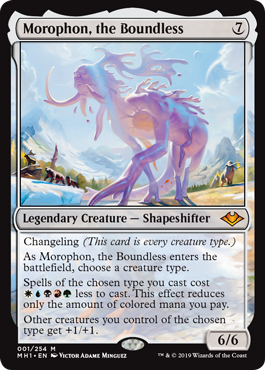
This card came about because my list of player wants included a giant number cards that essentially were commanders for specific creature types with the creature type suggestions being all over the board. I knew we couldn't design all of them, so I set out to make a card that could serve as a commander for any one creature type. My goal was simple: It had to be generally useful for any creature type and it had to have a five-color color identity so that any combination of colors could use it as the commander. The card went through multiple iterations, but I love the cost reduction ability being the clever way to make it have a five-color color identity (when I first designed it, it cost WUBRG). The +1/+1 ability has been there since the very first iteration, because what creatures don't enjoy getting bigger? I hope all the tribal Commander players have fun with Morophon.
That's all the time I have for today. I hope this article has given you a glimpse into how fun Modern Horizons is going to be. As always, I'm eager to hear any feedback on today's column, Morophon, the Boundless, or Modern Horizons in general. You can reach me through my email or on social media (Twitter, Tumblr, and Instagram).
Join me next week when I continue my story of Modern Horizons vision design.
Until then, may you too metaphorically enjoy this Autobahn.
#637: Social Media in Game Design
#637: Social Media in Game Design
In this podcast, I examine the role social media plays in modern game design.
#638: War of the Spark
#638: War of the Spark
44:00
This podcast talks about the vision design of War of the Spark.
- Episode 636 Rise and Fall of the Blocks
- Episode 635 Rabiah Scale, Part 2
- Episode 634 Rabiah Scale, Part 1

